You know that feeling when your inbox is overflowing, and every notification brings another customer question or request? It’s a sign of a thriving business, of course, but it’s also a major stressor.
Juggling those emails can be a real drain on your time and energy, pulling your focus away from development and growth. You need tools that help you thrive, while keeping your customers happy too.
So let’s talk email customer support tools! We’ll highlight the essential features to look for, and introduce you to four kinds of platforms that can transform your customer service process. Before that, let’s get a clearer picture of the problems these tools can (ideally) help you with.
Common Challenges Small Businesses Face in Customer Support
Providing exceptional customer support is crucial for any business. But when you’re facing big competitors, it’s especially important.
Retaining the buyers you have is more cost-effective than finding new ones. Plus, positive word of mouth from happy customers helps you stand out when direct advertising is prohibitively expensive.
At the same time, there are some challenges that make delivering great customer support an uphill journey for smaller companies. Here are four of the most common, and some practical solutions your customer support email tools need to offer.
Limited Budget and Resources
It’s tough prioritizing customer support with limited resources. And you may not be able to hire a robust support team to help.
However, it is possible to provide excellent customer support within those limitations. You can:
- Set up automations for rote tasks. Invest in email customer support tools that can handle repetitive tasks like sending canned responses or automated replies. This will free up your team’s time for more complex issues.
- Empower your customers to help themselves. Create a knowledge base or FAQ section to give customers the power to find answers on their own. This can significantly reduce the number of emails coming in, and improve the overall customer experience.
High Volume of Customer Requests
As your business grows, so do buyer inquiries and complaints. With a small team, even a modest customer base can quickly feel overwhelming. And if you’re offering a product or service with any level of complexity, such as software, you need to provide user support long after purchases are made.
A few ways to handle the influx effectively are:
- Establish clear communication channels. Create specific email addresses for different departments. This helps you route emails to the right team members and prevent confusion. For maximum efficiency, make sure these emails still connect to the same general inbox.
- Implement a ticketing system. Use email customer support tools that include a ticketing system. If there are features that let you organize inquiries and track progress, you can save time and ensure that your team responds to all requests.
- Offer alternative channels. Consider adding live chat or social media support as options to handle immediate issues and reduce email volume.
Demand for Quick Responses
Customers expect fast responses, especially when they have problems. A delayed reply can make them feel ignored and unimportant. Not only does this increase the odds that the customer will leave, it can damage your overall reputation.
To meet their needs, you can start by:
- Setting clear response time goals. Establish realistic response time targets, and communicate these expectations to both your team and customers. If buyers know upfront that you’re only available at certain times or can’t provide instant replies, you avoid unpleasant surprises.
- Embrace automation. You can use automated responses for common inquiries such as “Where’s my order?” to provide instant and relevant answers. Judicious use of AI can also help – a chatbot can point buyers towards basic information and self-help resources.
Small Team Size
Teamwork makes the dream work, but small teams often have their hands full. This makes customer service feel like a juggling act. The people providing support probably have other responsibilities to manage.
Here’s how you can create a seamless customer experience, even with a small team:
- Delegate wisely. Divide responsibilities based on team members’ skills. For example, a team member who is great at empathy might be good at handling customer complaints.
- Communicate effectively. Use a shared inbox or communication platform to keep everyone in the loop, and ensure consistent messaging across all customer interactions.
- Provide ongoing training. Invest in regular training sessions for your team to improve their customer service skills and keep them updated on product knowledge.
Key Features To Look for in Email Customer Support Tools
The right email customer support tools can help with all of the above problems (and more). They’ll need to be paired with careful planning, and adapted to your unique audience and niche.
Still, the right features can make a big difference in both efficiency and customer satisfaction. Here’s what we suggest you prioritize.
An Automated Ticketing System
Automated ticketing helps you manage customer emails by turning them into organized tickets. It’s useful if you have a lot of inquiries.
It’s essential if those inquiries come from more than one place. If you have multiple support emails, or use more than one channel to provide service (such as email and live chat), a ticketing system collates everything together. You can see everything at a glance, and respond in order of priority (or whatever workflow your team prefers).
If that system offers automation, it may be able to:
- Automatically prioritize urgent requests
- Categorize different types of inquiries
- Assign tickets to the right team members
A User-Friendly Interface and Plenty of Customization Options
An intuitive interface is critical, especially if your team has limited IT resources or time (or both!). It reduces the learning curve for your team and enhances productivity.
Quality email customer support tools also have well-organized central dashboards, customizable views, and easy-to-use ticket management features.
Customization features are also essential. These allow you to tailor the tool to your specific needs. You can make sure it aligns with existing (or desired) workflows, and supports the tasks your team performs regularly.
Key functionality to look for includes:
- Adjustable ticket fields and categories
- Flexible workflow rules and email automation options
- Customizable email templates and customer portals
Mobile Accessibility
Mobile accessibility enhances teamwork in customer support, by providing flexibility and connectivity. It enables real-time collaboration, allowing team members to address inquiries promptly from any location.
This improves response times, especially for time-sensitive requests. It also boosts productivity by facilitating task management and communication on the go.
Additionally, mobile apps with features like push notifications ensure seamless communication. This keeps everyone informed and aligned when resolving customer issues. So it’s a good idea to look for tools that offer fully-functional mobile apps for iOS and Android devices.
Integrations with Other Important Platforms
Integrations offer you a unified view of customer interactions. So consider whether you want to connect your email customer support tools with other business applications. This might include Customer Relationship Management (CRM) systems, social media platforms, and alternate support channels.
Integrations can also offer:
- Increased efficiency. Switching back and forth between multiple platforms takes time, and makes it easier to overlook things. The more data and tasks you can pull into the same place, the better.
- Enhanced communication. You can manage inquiries from various channels within a single interface. This ensures prompt and streamlined communication.
- Improved data insights. You’re able to collect and analyze data across platforms to gain insights into customer behavior.
Analytics and Reporting
Tracking key metrics provides valuable insights into your customer support operations. It helps you make data-driven decisions to improve support and enhance the customer experience.
At the same time, many analytics platforms are expensive and complicated. It’s a lot easier to manage this within your email customer support tools, and only focus on what really matters.
Built-in analytics and reporting features let you:
- Track key performance indicators (KPIs) such as response times and resolution rates
- Identify trends in customer inquiries, so you can understand common issues and areas for improvement
- Measure agent performance to optimize resource allocation and identify areas for training or development
4 Types of Email Customer Support Tools and How They Compare
Now that you know what to look for, let’s explore the different types of email customer support tools that are available.
While there are many options out there, most fall into four broad categories. So before delving into specific platforms, it’s best to start with the big picture and figure out what kind of tool you really need.
1. Traditional Email Clients
Using a traditional email client like Gmail or Outlook can seem like the easiest option for customer support. After all, they’re:
- Readily available
- Familiar to most people
- Free to use
But for small businesses, relying solely on these tools can quickly become a bottleneck. They fall short due to:
- Limited functionality. These clients lack dedicated features for customer support, such as ticketing systems, automated workflows, and in-depth analytics.
- Organizational challenges. Keeping track of customer inquiries and collaborating with your team can become difficult. Imagine trying to track customer orders through a cluttered inbox, or struggling to collaborate when everyone is managing their own emails independently.
- Lack of automation. Sending welcome emails, order confirmations, or follow-ups usually requires manual intervention, which wastes time and can lead to inconsistencies.
Traditional email clients can be a good starting point for brand-new businesses. If you work alone or have a single support address that only one or two people use, Gmail or Outlook may be perfectly sufficient.
As your team and customer base grows, however, they can become a bottleneck. They’re good at what they do – they’re just not designed for customer service. Limitations are inevitable.
With Gmail in particular, you can circumvent that somewhat by opting into the entire ecosystem of Google tools. However, most of those are designed with the needs of mid-sized to enterprise businesses in mind, so that approach becomes expensive and complex.
Once you have multiple people handling support through various addresses, or you’re helping customers via live chat and social media alongside email, a platform designed specifically for those tasks becomes invaluable. In the next three sections, we’ll look at more purpose-built categories of email customer support tools.
2. Ticketing Systems
A ticketing system transforms incoming emails into structured units called ‘tickets’. Each ticket contains essential information about the customer’s inquiry. This type of organization allows support teams to prioritize, assign, and track the progress of each customer issue.
More specifically, these email customer support tools might offer:
- Ticket creation and conversion. Automatically converts incoming emails into tickets, assigning unique identifiers for easy tracking.
- Ticket prioritization. Allows teams to categorize and prioritize tickets based on criteria like urgency or customer importance.
- Workflow automation. Enables the creation of rules to automatically route tickets to appropriate team members or departments.
- Collaboration tools. Facilitates team communication through internal notes, ticket assignment, and status updates.
- Basic reporting. Provides insights into ticket volumes, response times, and resolution rates to help improve support processes.
- Customizable fields. Allows businesses to add custom fields to tickets, in order to capture additional relevant information.
- Email templates. Offers pre-written responses for common inquiries to speed up reply times and ensure consistency.
The Benefits and Challenges of Opting for a Ticketing System
So what are the advantages of ticketing systems over traditional email clients? You benefit from:
- More efficient organization. Centralizing customer inquiries saves time, and reduces the risk of overlooked emails.
- Improved response times. Automation and prioritization features help teams address urgent issues quickly.
- Increased accountability. Ticket ownership and tracking features prompt your team to follow up on each inquiry.
On the other hand, there are some downsides to be aware of when using these email customer support tools:
- Higher learning curve. Ticketing tools in particular can be short on usability features, and require more time and technical know-how to use effectively.
- Limited functionality. A system built solely for ticketing may struggle if you try to use it for all of your customer service tasks. You’re likely to face limitations in the feature set, collaboration functionality, and integration options.
- Limited flexibility. Many ticketing systems are designed to rote inquiries in a handful of pre-designed ways. If all (or most) of the customer messages you get are simple and repetitive, you might be fine. But if customers reach out through various channels with all kinds of questions and requests, you may find it harder to organize and respond to them effectively.
- Less-than-optimal customer experience. It’s harder to provide a truly high-quality customer experience with a ticketing system. The streamlining and lack of personalization can make it hard to help each buyer in a personalized, targeted way. On their end, your support may look dispassionate and even robotic.
If you just need to offer basic tech support, or if your customers tend to be one-time buyers rather than long-term users, a ticketing system might be sufficient. If you’d prefer a more ‘total package’ solution for customer service, you might want a platform that combines ticketing with other key features.
3. Helpdesks
In a way, a helpdesk is similar to a ticketing system. In fact, it usually includes a complete setup for creating and managing tickets, as described above.
However, a helpdesk goes beyond that to provide a more complete solution. It offers email customer support tools for managing inquiries effectively across various channels, and creating a more cohesive buyer experience.
Every helpdesk is a little different. Features you’ll often find include:
- Ticket creation and assignment. Intelligently route inquiries to the most appropriate team member based on factors like expertise and availability. This ensures that every customer gets timely and efficient support.
- Integration with all your support channels. Along with email, you should be able to connect your live chat, phone support, social media profiles, and any other tools that matter to your business.
- Flexible organization and prioritization. A quality helpdesk should let you organize customer communications however you like, make sure they’re tackled in the right order, and send inquiries immediately to the team members best equipped to handle them.
- Features that enhance collaboration. Make it easier for your support team to work together with a centralized inbox, along with internal commenting and notes functionality.
- Automation capabilities. This is a big category, but a helpdesk should offer some ways to increase efficiency without sacrificing quality of service. This might include the ability to create response templates you can personalize and send quickly, along with thoughtful use of AI.
- Performance tracking. Get insights into key metrics such as response times, resolution rates, and customer satisfaction. This data helps you optimize your support operations and identify areas for improvement.
- Self-service resources. Customer support is about more than your direct interactions with buyers. Some helpdesks make it easier to set up self-serve resources for people to use autonomously, such as a knowledge base.
The Benefits and Challenges of Opting for a Helpdesk
A helpdesk is more than just a convenient tool. It’s a strategic investment for businesses looking to scale and deliver exceptional customer experiences. Here’s why:
- Centralized inquiry management. All customer interactions are stored in one place. As a result, you get a comprehensive view of each customer’s history. This makes it easier to understand your customers and provide a more personalized experience.
- Increased efficiency. Helpdesks streamline workflows and automate repetitive tasks. This way, your customer support team can focus on issues that require human help and provide faster responses.
- Data-driven insights. Reporting features help you identify trends in customer inquiries, and track agent performance. Plus, with customer data housed in the same place, you can more easily contextualize what you learn.
- Better scalability. If you opt for a traditional email client or a basic ticketing system, you’re more likely to outgrow it as your needs evolve. Having to change platforms can be a hassle. A helpdesk provides a full suite of tools so it can grow alongside your business.
As with all email customer support tools, there are a few potential challenges to keep in mind:
- Higher complexity. Helpdesks typically have more features than simpler ticketing systems. This can mean a steeper learning curve for your team. You’ll want to try before you buy, and look for a tool with a user-friendly interface and easy setup.
- Potential costs. Some helpdesks can be pricey, while others are more affordable. So make sure you understand the costs involved, and what’s included in each plan or tier. You don’t want to end up paying for features you’re not using. On the other hand, you may want to ensure that those features are available at higher price points, in case you do want them in the future.
Introducing Groove: A Helpdesk Built for Your Small Business
Helpdesks are ideal for growing businesses that are:
- Managing multiple support channels (email, chat, social media, phone), or even just more than one support email address
- Scaling their service team, and in need of a system that can handle increasing volumes of inquiries
- Looking for easy-to-understand reporting and analytics
- Focused on providing exceptional and personalized customer experiences
For most small businesses, a helpdesk is the best of the many customer service email tools available. That’s why we built Groove:

Groove has helped many businesses provide top-quality customer support, thanks to features like:
- A user-friendly interface. Groove’s intuitive design makes it easy for anyone to use effectively, even if you’re new to helpdesks.
- Seamless channel integration. You can manage all of your customer interactions – email, live chat, and social media – in a single shared inbox.
- Smart automation. Groove’s rules engine automates routine tasks, boosting team efficiency.
- Collaborative tools. Groove’s collaborative tools, such as internal notes and @mentions, facilitate efficient communication and help you resolve challenging support issues quickly.
- Customizable knowledge base. Thanks to the built-in knowledge base feature, reduce the number of support tickets and let your team focus on more complex issues.
- Clear and easy-to-understand analytics. You can track key metrics, identify trends, and make data-driven decisions to optimize your customer support strategy.
- Dedicated mobile apps. Provide support from anywhere, via iOS and Android devices.
- Scalable pricing. Groove’s pricing model grows with your business, ensuring that you only pay for what you need.
Best of all, Groove is very easy to get started with. If you’re already using Gmail or Outlook for customer support, you can connect your support addresses in minutes, and the interface will feel refreshingly familiar.
But we wouldn’t ask you to take all that on faith – check out the free trial, and we’re confident you’ll see the difference Groove’s email customer support tools can make!
How To Get Started with Groove
If you’d like to give Groove a try, or simply see what a helpdesk looks like in action, here’s a quick preview.
Since Groove is a cloud-based platform, you’ll start by signing up for an account. Then you can create your central hub for customer support – in other words, your shared inbox.
To do so, click on Connect Inbox, choose a name (e.g. “Customer Support”), and add an email address you want to use (or are already using):

You can repeat that process for as many inboxes as you need. Don’t forget to visit the Apps > Integrations section as well, to connect other key channels like live chat or Shopify:
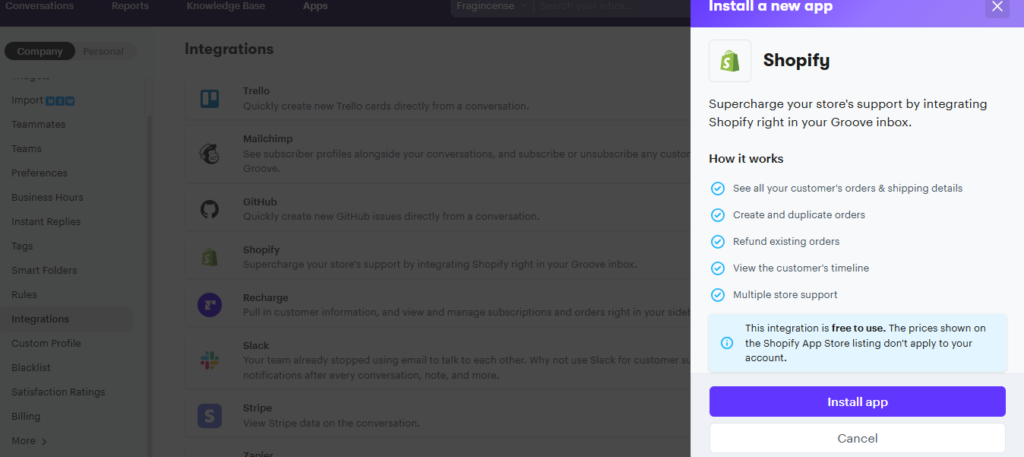
Then it’s time to get your team onboard! Here’s how to invite them to join your Groove account:
- Click on Apps
- Go to the Teammate section
- Select Add Teammate
- Enter their email address and assign a role
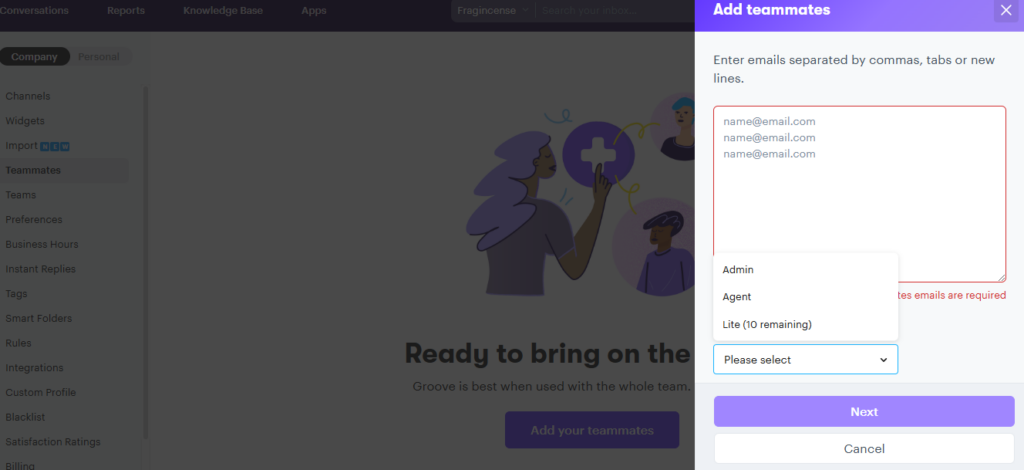
Familiarizing Yourself with Some Key Groove Features
After that, you can start exploring all the email customer support tools Groove has to offer. Let’s look at just a few examples.
You can save time and ensure consistent messaging by creating templates for common responses:
- Navigate to Apps > Instant Replies
- Click on Create Your First Reply
- Fill in the required fields to match your preferences, and hit Create
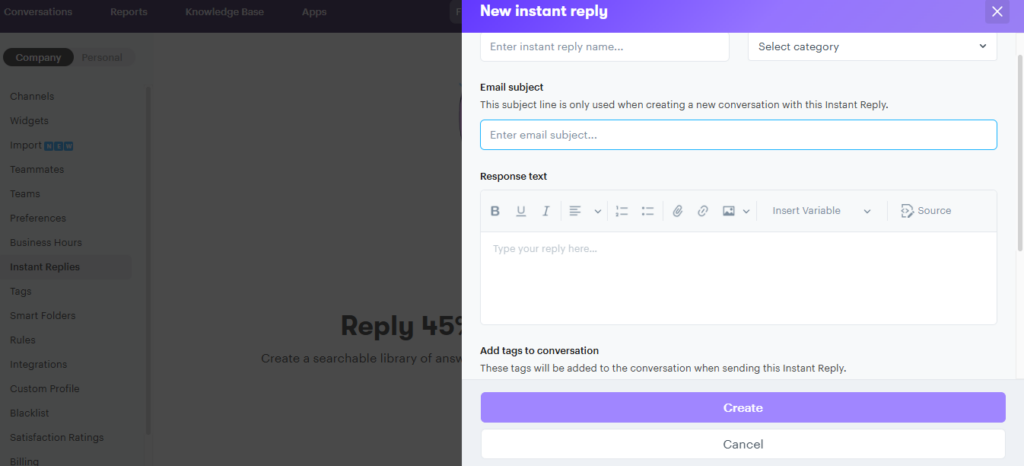
The Rules feature is a game-changer for automating repetitive tasks and streamlining workflows:
- Go to Apps > Rules
- Click on Create New Rule
- Set up conditions and actions (for example, you can automatically assign tickets to specific team members based on keywords)
- Check out the rule templates for an easier start
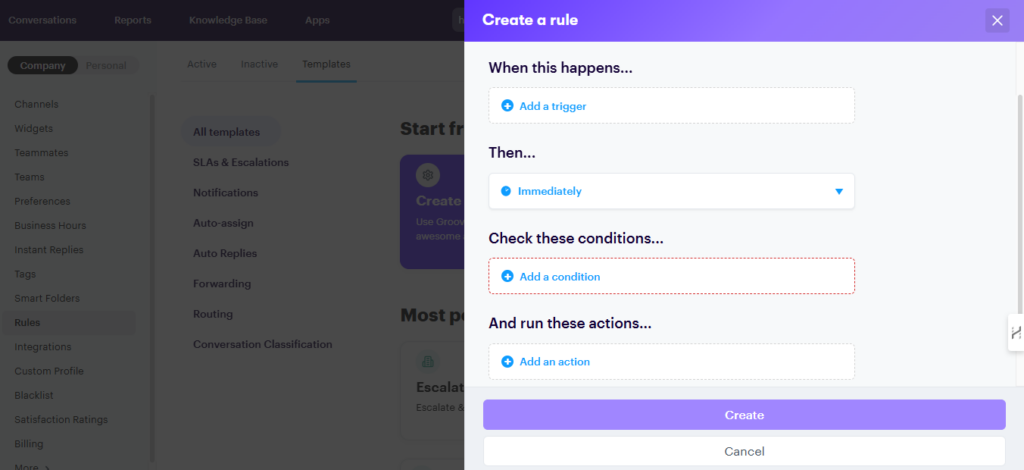
You can also create a self-service portal for your customers, to empower them to find answers on their own:
- Go to the Knowledge Base section
- Click on Create Your Knowledge Base, and give it a name
- Select Create Article
- Write and publish helpful content for common customer queries!

If you’re interested in metrics, Groove’s reporting dashboard gives you a clear view of your support team’s performance and customer feedback:
- Go to Apps > Satisfaction Ratings
- Click on Enable CSAT for Your Account
- Fill in the required fields, and then select Enable Satisfaction Ratings
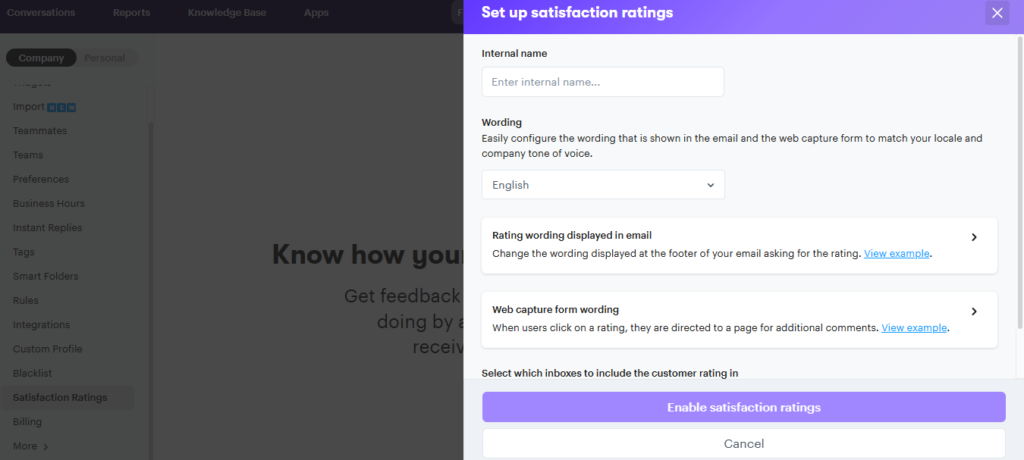
For more details, check out our Quickstart Guide and our other knowledge base resources.
4. Customer Relationship Management (CRM) Systems
Last up, Customer Relationship Management (CRM) platforms provide a holistic view of customer interactions across various touchpoints. They offer a lot more than just email customer support tools.
Even more so than helpdesks, CRMs vary pretty widely. Typically, you get access to features for managing sales and marketing, along with much more detailed analytics.
Some of the other relevant options you may get access to include:
- Email logging. Automatically captures all customer emails within contact profiles. This provides a comprehensive history of interactions, helping your team understand customer needs.
- Personalized responses. Leverages customer data to personalize emails, offers, and communications.
- Email automation. Sets up automated email campaigns and follow-ups based on customer interactions. This helps you stay organized and improve efficiency.
- Customer journey mapping. Offers a visual representation of the entire customer lifecycle. This allows you to optimize your processes and provide a seamless customer experience.
The Benefits and Challenges of Opting for a CRM
CRMs tend to focus on helping you with:
- Lead management. Reach out to new leads, nurture them through the customer journey, follow up as needed, and encourage them to convert.
- Improving ROI. Maximize customer lifetime value via ongoing communication, upsells and cross-sells, etc.
- Fully customized and streamlined workflows. If you want to set up elaborate and customized systems for engaging with customers, a CRM can be helpful.
- Collecting data-driven insights. A CRM typically goes much deeper into metrics than a helpdesk, covering data outside of what you need for optimizing customer support. You can gain insights into buyer behavior, sales trends, and more to make informed decisions.
When specifically considering CRMs as email customer support tools, you’ll want to be aware of the:
- Added complexity. CRMs can be complex systems with many features, requiring time and effort to learn and implement effectively. This may require investment in training and onboarding for your team, and a higher level of tech-savviness.
- Increased cost. CRMs can be more expensive than dedicated ticketing systems or helpdesks – sometimes a lot more. They’re usually designed with larger businesses in mind, and their design and pricing reflects that.
- Reduced specialization. While most (if not all) CRMs do incorporate customer service functionality, many focus more on sales. So their support-specific features can be less comprehensive/flexible. Alternately, a CRM that provides all the support features of a helpdesk alongside a full suite of other options is likely to be expensive and have a steep learning curve.
Who Should Use a CRM?
In most cases, CRMs are best suited for businesses that:
- Are looking to build stronger customer relationships and provide more personalized experiences at scale
- Want a tool for handling many different business needs, including sales and support
- Need a robust solution that can be fully customized
- Require advanced reporting and analytics capabilities for data-driven decision-making
Finally, if you already use a CRM for sales and marketing, but its support features are lacking, you may be able to integrate it with a helpdesk. This is easier than switching platforms, and gives you access to the widest possible toolset.
While a CRM system alone isn’t enough for full customer support, it becomes very effective when used with a helpdesk. Together, they can greatly improve how you manage customer relationships, make your business more efficient, and enhance the customer experience.
Maximize Your Email Customer Support with Groove
The right email customer support tools can do a lot for your small business. They allow you to provide an experience that’s comparable to what your larger competitors offer, without investing more time and money than you can spare.
Hitting that sweet spot means finding a tool that offers everything you need – and may want soon as your customer base grows – without unnecessary complexity or cost. If you have more than one support channel and at least a few team members handling customer service, a helpdesk strikes the perfect balance.
Ready to elevate your customer support? Try Groove for free today, and experience the benefits firsthand!





